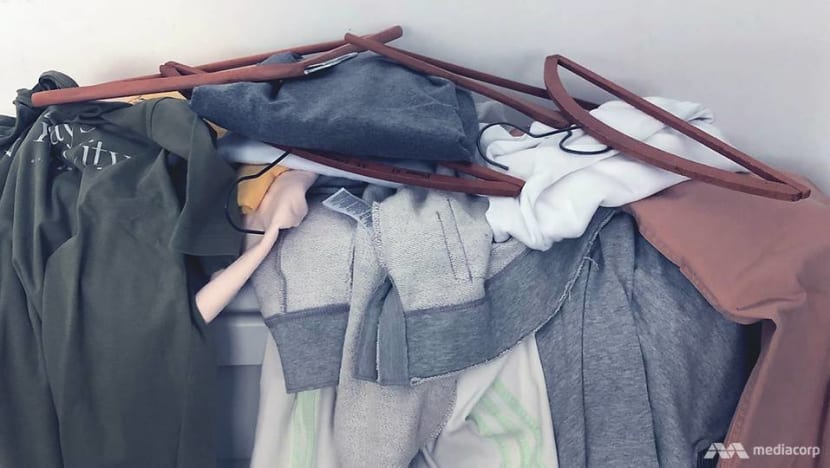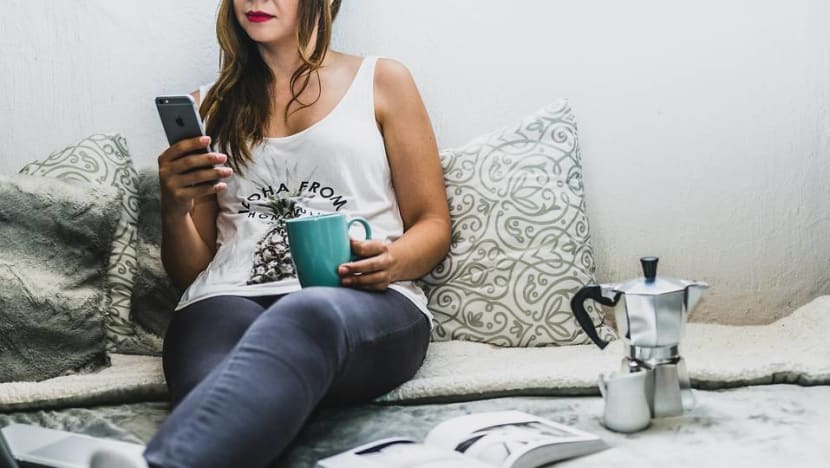commentary Commentary
Commentary: I tried shopping for new clothes for Chinese New Year. It went abysmally
With the unrelenting COVID-19 situation, many are going out less and working from home as far as possible. No wonder people are leaving clothing shops empty-handed.

Buying new clothes just doesn't have the same kind of appeal anymore, says CNA's Erin Low. (Illustration: Rafa Estrada)
SINGAPORE: With Chinese New Year around the corner, tradition beckons those who celebrate it to go shopping for clothes. A spanking new outfit, preferably incorporating lots of red, symbolises a fresh start to the new year.
So I did something that I haven’t done in about a year: Go to the mall for the sole purpose of buying clothes.
But as I sifted through rack after rack of clothing, reality slowly set in. I didn’t want to buy anything.
A pang of guilt hit too when I recalled the few brand new dresses tucked away in my wardrobe, reserved for a special occasion that never came after the pandemic struck.
I went back home empty-handed.
READ: Commentary: Fresh COVID-19 restrictions are turning Chinese New Year into a social landmine for families
NEWFOUND DISINTEREST IN DRESSING UP
While ambling about the mall aimlessly, I noticed how stalwarts like Cotton On and Nike were bustling, while the dressier boutiques were emptier.
For the latter, a few shoppers were browsing the sales racks, but nobody was getting in line at the cashier.
It makes sense that nobody’s really buying fancy clothes. Looking back on the few occasions I bought clothes last year, they’ve only been for functional needs: Basic, versatile pieces that can be worn at home or outside, workout gear and comfy sleepwear.
While this stripped down ensemble has been freeing, I had been looking forward to Chinese New Year, which for the women in my family is a time when we can compliment each other on our new kebayas or carefully curated outfits.
READ: Commentary: Chinese New Year shouldn’t be the only time we meet our extended family

But with the pandemic limiting how much visiting we can do and the number of people we can meet, my will to dress up this year has dried up.
It’s not just these new restrictions – the wider COVID-19 malaise has disrupted our relationship with clothes. Our newfound disinterest in dressing up has been reflected in rock-bottom sales figures: In the US, 2020 sales in clothing and accessories declined more than a quarter compared to 2019, the steepest drop across all retail sectors.
Likewise, apparel and footwear sales were also battered in Singapore. It all started during the circuit breaker from Apr 7 to Jun 1, 2020, which was a particularly dire period for retail.
In May 2020, year-on-year retail sales halved, the worst drop since records began in 1986. Apparel and footwear sales shrunk by almost 90 per cent.
This trend likely won’t let up. As COVID-19 continues to disrupt trade and travel worldwide, McKinsey predicts that global fashion sales in 2021 could remain up to 15 per cent lower than 2019 levels.
READ: Commentary: Missing the thrill of dressing up for work as a man
READ: Commentary: How trendsetting brand Topshop fell behind the times
FASHION WAS IN CONSTANT OVERDRIVE
This collapse in retail has had huge implications for people and jobs.
Over the last year in Singapore, beloved department store Robinson’s bowed out, along with clothing retailers Topshop and Esprit.
Part of it might be a long overdue correction, given the constant overdrive fashion supply chains were in pre-coronavirus.
READ: Commentary: Robinsons shuttered for good. Does Singapore have too much retail space?

In 2018, the average consumer in the US bought 68 pieces of clothing in a year, wearing each piece an average of seven times before tossing it out. A 2016 CNA survey revealed that the average Singaporean buys 34 pieces and throws out 27 per year.
But the free-fall of clothing sales have pummelled garment manufacturers and workers. As demand for clothing plummeted, retailers cancelled their orders, leaving clothing manufacturers in the lurch.
Bangladesh, the world’s second largest garment exporter, lost more than US$3 billion in cancelled payments. Over half of its 4 million-strong workforce was laid off, and hundreds of garment workers clashed with police throughout last year at protests over outstanding wages.
With workers unpaid and unworn clothing piled high in warehouses, the pandemic has shown the fever pitch at which clothes used to be produced, consumed and discarded.
Sustainability advocates have long decried the overconsumption of clothes. According to the UN Environment Programme, as of 2018, the fashion industry emits 10 per cent of the world’s carbon emissions, more than international flights and maritime shipping combined (both sectors produce around 2 per cent of global emissions each).
READ: Commentary: Following a T-shirt from cotton field to landfill shows the true cost of fast fashion
READ: Commentary: Secondhand clothing sales are booming – and could be the answer to fashion’s sustainability crisis
OUT WITH THE OLD?
Still, these trends do not spell the end of fashion.
According to Singaporean market researcher Blackbox, COVID-19 has led to the boom of e-commerce, with the average Southeast Asian consumer spending a third more on online goods.
Shopee, Singapore’s most visited e-commerce site, saw an 82 per cent quarterly increase in web visits over June to August 2020.
And let’s face it. Even if the pandemic has killed off brick-and-mortar clothes retailers, we will still buy clothes, just maybe through our smartphones after being accustomed to getting all we want via e-commerce.

Brands know this and are responding. H&M announced it will close hundreds of its stores worldwide, as part of its broader strategy to shift its operations online.
But what the pandemic has provoked may be a deeper, unseen change in consumer priorities and consciousness over consumption that will reshape retail in larger ways.
Fifty-four per cent of Southeast Asian consumers want to buy from brands with sustainable practices, while 43 per cent of Singaporean consumers are deliberately choosing to do so, according to a UOB survey in Dec 2020.
READ: Commentary: Why luxury brands are weathering the pandemic better than other retailers
Sustainable fashion had piqued my interest too, and when I was looking for tops that were presentable for work Zoom calls yet comfy enough for pottering about the house, I chose to buy my first “sustainable” basics: A cap-sleeved shirt and a drapey tank top.
They’re made of lyocell, a bamboo-based fibre that has a lower carbon and water footprint compared to cotton. The brand also strives for transparency, and provides information on the factory it works with and its workers’ salaries.
The price tag was eye-watering, but with all the money I saved from dining out less often, and of course, buying less clothes, my wallet didn’t hurt too much.
It helps also that those tops are unbelievably soft and breathable.
READ: Commentary: Life after COVID-19 – fashion's excesses curbed, shopping habits forever changed
The thrill of buying new clothes is undeniable. Even as clothing sales remain depressed, COVID-19 won’t extinguish our desire to look good and to experiment with new things.
But that desire in me just wasn’t strong enough to fork out for new clothes this Chinese New Year. As long as work from home remains the norm, loungewear and athleisure will be my go-to.
Maybe what we really should be saying goodbye to are clothes with buttons and collars, while we usher in the new year with oversized tops and drawstring pants.
Listen to infectious disease professors break down the latest COVID-19 restrictions and how they might be carried out during Chinese New Year on CNA's Heart of the Matter podcast:
Erin Low is research writer at the CNA Commentary section.














